The Role of Testosterone and Gibberellic Acid in the Melanization of Cryptococcus neoformans
- PMID: 32922377
- PMCID: PMC7456850
- DOI: 10.3389/fmicb.2020.01921
The Role of Testosterone and Gibberellic Acid in the Melanization of Cryptococcus neoformans
Abstract
Cryptococcus neoformans, a spore-producing pathogenic yeast, affects immunocompromised individuals causing meningoencephalitis. Once C. neoformans is introduced via the respiratory tract, it is engulfed by macrophages and other phagocytes. One of C. neoformans's primary virulence factors is the pigment melanin, which is formed in the cell wall and protects the yeast against UV radiation and oxidizing agents produced by macrophages during phagocytosis. To better understand the observed sex bias (3:1; male:female) in C. neoformans infections, the phenotype of various virulence factors was determined in the presence of exogenous sex hormones. C. neoformans melanized faster in the presence of testosterone than it did in the presence of estradiol. Using a combination of RNA sequencing analysis and ELISA results, we identified a growth hormone, gibberellic acid (GA), produced in C. neoformans that was highly upregulated in the presence of testosterone. A variety of knockout strains of genes involved in the GA biosynthesis pathway showed significantly reduced melanization in the presence of testosterone. Additionally, inhibitors of GA also reduced melanization in the presence of testosterone. Thus, these data suggest that the gibberellic biosynthesis pathway is involved in melanization in C. neoformans, and the melanization difference observed in the presence of testosterone may be due to increased production of GA, which may partly explain the sex bias observed in C. neoformans infections.
Keywords: Cryptococcus neoformans; gibberellic acid; melanization; pantothenic acid; testosterone.
Copyright © 2020 Tucker, Guess and McClelland.
Figures
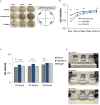

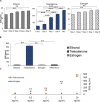

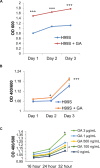
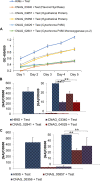
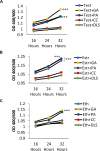

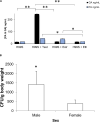
Similar articles
-
Cryptococcus neoformans can utilize the bacterial melanin precursor homogentisic acid for fungal melanogenesis.Appl Environ Microbiol. 2007 Jan;73(2):615-21. doi: 10.1128/AEM.01947-06. Epub 2006 Nov 10. Appl Environ Microbiol. 2007. PMID: 17098915 Free PMC article.
-
Melanization in Cryptococcus neoformans Requires Complex Regulation.mBio. 2020 Feb 4;11(1):e03313-19. doi: 10.1128/mBio.03313-19. mBio. 2020. PMID: 32019794 Free PMC article.
-
The effect of L-DOPA on Cryptococcus neoformans growth and gene expression.Virulence. 2011 Jul-Aug;2(4):329-36. doi: 10.4161/viru.2.4.16136. Epub 2011 Jul 1. Virulence. 2011. PMID: 21705857 Free PMC article.
-
[Melanin and its role on the virulence of Cryptococcus neoformans].Mikrobiyol Bul. 2010 Jul;44(3):519-26. Mikrobiyol Bul. 2010. PMID: 21064003 Review. Turkish.
-
Melanin and fungi.Curr Opin Infect Dis. 2003 Apr;16(2):91-6. doi: 10.1097/00001432-200304000-00005. Curr Opin Infect Dis. 2003. PMID: 12734441 Review.
Cited by
-
Characterization of melanin from the fungus Scolecobasidium Musae and its antioxidant and photoprotective properties.Arch Microbiol. 2025 Mar 6;207(4):77. doi: 10.1007/s00203-025-04279-2. Arch Microbiol. 2025. PMID: 40047961
-
Cryptococcus neoformans: Brain Preference, Gender Bias, and Interactions with Mycobacterium tuberculosis and Toxoplasma gondii in HIV-Positive Patients.Microorganisms. 2025 Feb 21;13(3):481. doi: 10.3390/microorganisms13030481. Microorganisms. 2025. PMID: 40142374 Free PMC article.
-
Clinical and mycological implications of cryptococcal meningitis in Iran.Heliyon. 2023 Oct 21;9(11):e21395. doi: 10.1016/j.heliyon.2023.e21395. eCollection 2023 Nov. Heliyon. 2023. PMID: 37908716 Free PMC article.
-
Associations between Cryptococcus Genotypes, Phenotypes, and Clinical Parameters of Human Disease: A Review.J Fungi (Basel). 2021 Mar 30;7(4):260. doi: 10.3390/jof7040260. J Fungi (Basel). 2021. PMID: 33808500 Free PMC article. Review.
-
Production of Fungal Pigments: Molecular Processes and Their Applications.J Fungi (Basel). 2022 Dec 28;9(1):44. doi: 10.3390/jof9010044. J Fungi (Basel). 2022. PMID: 36675865 Free PMC article. Review.
References
-
- Bisson G. P., Nthobatsong R., Thakur R., Lesetedi G., Vinekar K., Tebas P., et al. (2008). The use of HAART is associated with decreased risk of death during initial treatment of cryptococcal meningitis in adults in Botswana. J. Acquir. Immune Defic. Syndr. 49 227–229. 10.1097/QAI.0b013e318183181e - DOI - PMC - PubMed
LinkOut - more resources
Full Text Sources

